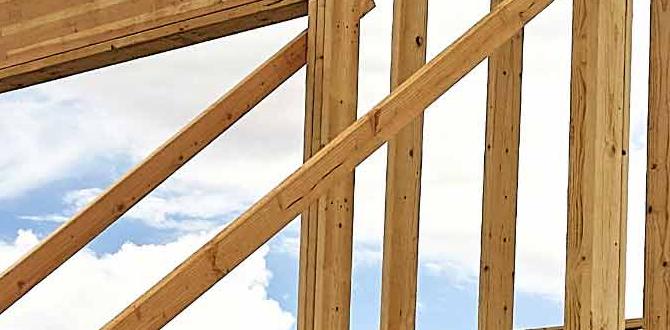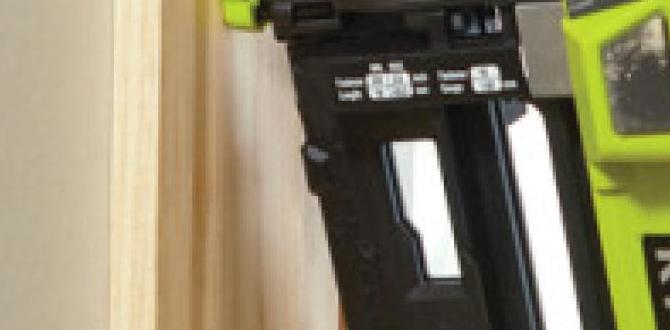Quick Summary: Slow fire mode on nailers offers enhanced control and precision, preventing accidental firing. It’s ideal for detailed work, repositioning, and ensuring safety when working near sensitive areas. Mastering this feature boosts your confidence and project quality.
Hey folks, Jack Shaffer here from Nailerguy! Ever felt a surge of adrenaline when your nailer fired a bit too soon, maybe nicking your workpiece or making you jump? It happens to the best of us, especially when we’re getting started. Those powerful tools are fantastic for getting jobs done, but sometimes, a little more control is exactly what we need. Thankfully, many modern nailers come equipped with a game-changer: slow fire mode. This isn’t some fancy, overly complicated feature. It’s designed to give you, the user, more command over when that nail actually goes in. We’re going to dive deep into what slow fire mode is, why it’s a total lifesaver for your projects, and how you can start using it to nail with confidence. Get ready to say goodbye to those little oops moments and hello to cleaner, more precise work!
Table of Contents
Understanding Slow Fire Mode in Nailers
So, what exactly is this “slow fire” mode we’re talking about? Think of it as your nailer’s personal “think before you shoot” button. Most common nail guns operate in either “contact actuation” (bump fire) or “sequential actuation” (single shot). Slow fire mode is typically a setting within sequential actuation, or a distinct mode on some tools, that deliberately slows down the tool’s readiness to fire after the previous nail has been driven.
Instead of instantly being ready for the next trigger pull and contact with your material, a nailer in slow fire mode introduces a slight, intentional delay. This delay might be fractions of a second, but it’s enough to make a world of difference. It’s not about making the nailer sluggish; it’s about giving you a crucial moment to ensure everything is perfectly aligned before the next nail is driven.
Contact Actuation vs. Sequential Actuation (A Quick Refresher)
Before we get too deep into slow fire, let’s quickly recap the two primary firing modes:
- Contact Actuation (Bump Fire): This is the faster mode. You hold the trigger down, and the nailer fires every time you press the nose of the gun against your material. Great for speed with non-critical, repetitive tasks like framing. However, it requires careful trigger control to avoid accidental fires.
- Sequential Actuation (Single Shot): Here, you must press the nose of the nailer against the material first, then pull the trigger to fire a single nail. This is the safer and more precise mode, perfect for detailed work where exact placement is key.
Slow fire mode usually builds upon sequential actuation. While sequential actuation requires a two-step process (nose touch, then trigger pull), slow fire adds that extra pause after the nailer is ready to fire again, ensuring you intentionally want to press the trigger again after you’ve already placed the nailer.
The Essential Benefits of Using Slow Fire Mode
Now, let’s get to the good stuff! Why should you even bother with this “slow fire” setting? The benefits are pretty significant, even if they seem subtle at first glance. They all boil down to giving you more control, which leads to better results and a safer working environment.
1. Enhanced Precision and Accuracy
This is probably the biggest win. When you’re working on projects that require a high degree of accuracy—think delicate trim work, cabinet building, or anything where a misplaced nail can ruin the aesthetic—slow fire is your best friend. It gives you those extra moments to:
- Ensure the nailer is perfectly flush against the surface for a clean drive.
- Adjust the exact placement of the nail before firing.
- Confirm you’re not about to nail into a knot or a weak spot that could split your wood.
This deliberate pause means fewer “oops” nails and more perfectly aligned fasteners, giving your projects a professional, polished look. It’s like having a tiny safety net for your precision work.
2. Increased Safety and Accident Prevention
Safety is paramount when working with any power tool, and nailers are no exception. Accidental nail discharge can happen even in sequential mode if you’re not careful, especially if you’re tired or working in an awkward position. Slow fire mode acts as an excellent safety buffer:
- Prevents Accidental Discharge: If you bump the tool slightly or your hand slips, the delay gives you a chance to react and prevent the nail from firing unexpectedly.
- Clearer Intent: The intentional pause reinforces the act of firing, making it less likely to happen by accident. You have to actively decide to pull the trigger again after placing the nail.
- Working Near Yourself or Others: This mode is invaluable when you’re working in tight spaces or when others might be nearby. It reduces the risk of the nail going in an unintended direction.
For beginners especially, this mode builds confidence by providing a more forgiving firing mechanism. It teaches good habits by enforcing a moment of deliberation before each shot.
3. Better Control for Tricky Materials and Angles
Some materials are trickier to work with than others. Thin veneers, delicate hardwoods, or even angled joints can present challenges. Slow fire mode helps you:
- Drive Nails Gently: For very thin materials, a full-speed bump fire or standard sequential fire might drive the nail too hard, causing the head to sink too deep or even split the material. The controlled firing of slow mode can help mitigate this.
- Nail at Angles: When you’re not working perfectly perpendicular to the surface, the risk of the nail glancing off or not seating properly increases. Slow fire allows you to ensure the nailer is seated as well as possible before firing, leading to a straighter drive.
- Working Near Edges: Nailing close to the edge of a board is risky business. A premature nail can blow out the edge. The controlled firing of slow mode gives you better control to place the nail exactly where you want it without risking structural integrity or appearance.
4. Ideal for Repositioning and Fine-Tuning
Picture this: you’ve just placed your nailer, ready to fire, but you realize you want to nudge the workpiece just a hair. In bump fire, this could be a disaster. In standard sequential, you might have to detach the nailer and re-seat it. With slow fire, you can release pressure, make a tiny adjustment, and then firmly re-seat the nailer. Because of the intentional delay, you’re less likely to fire an accidental nail during these minor repositioning maneuvers.
5. Building Confidence and Reducing Errors
For anyone new to using nail guns, the power and speed can be intimidating. Slow fire mode is a fantastic tool for building confidence. By inherently slowing down the process, it:
- Reduces the likelihood of costly mistakes.
- Allows you to focus on technique rather than just speed.
- Helps you develop a better feel for the tool and how it interacts with different materials.
As you gain experience, you’ll find yourself relying on this mode less for every single nail, but having it available for those crucial moments will always be invaluable.
Table: Comparing Nailer Firing Modes
| Feature | Contact Actuation (Bump Fire) | Sequential Actuation (Single Shot) | Slow Fire Mode (often part of Sequential) |
| :—————- | :—————————- | :——————————— | :—————————————- |
| Speed | Fastest | Moderate | Slower than standard sequential |
| Control | Lowest | Moderate | Highest |
| Precision | Low | High | Very High |
| Safety | Lowest | High | Very High |
| Best For | Framing, attaching sheathing | Trim, cabinetry, general assembly | Detailed trim, fine woodworking, learning |
| Risk of Accidental Fire | High | Low | Very Low |
How to Engage Slow Fire Mode on Your Nailer
The exact method for activating slow fire mode will vary slightly depending on the make and model of your nail gun. However, the general principles are usually quite similar. Always refer to your nailer’s owner’s manual for the most accurate instructions for your specific tool.
Generally, you’ll look for a selector switch or button on the tool itself. Here are common ways it’s implemented:
Finding the Mode Selector
Most modern nailers have a switch, dial, or a button that allows you to change firing modes. This is often located:
- Near the trigger assembly.
- On the body of the nailer.
- Sometimes integrated into a digital display or control panel on higher-end models.
Common Mode Designations
Look for markings that indicate different firing modes. These might include:
- “S” or “Seq” for Sequential Actuation.
- “C” or “Bump” for Contact Actuation.
- “LS” or a similar designation for Low Speed, Limited Speed, or Slow Fire. Some manufacturers might just have a dual-mode selector where you press the trigger once for a single shot, and then the tool maintains a “ready” state for a few moments before resetting, effectively creating the slow-fire feel.
Some tools might not have a dedicated “slow fire” setting but achieve a similar effect through their sequential mode design. The key is that the tool is not instantly ready to fire again after the previous nail is driven. You must intentionally press the trigger again after placing the nailer.
Activating the Mode: Step-by-Step (General)
- Power Off and Disconnect Power Source: Before making any adjustments, ensure your nailer is powered off and disconnected from its power source (battery removed, air hose disconnected). This is crucial for safety.
- Locate the Mode Selector: Examine your nailer for the mode selection switch or dial.
- Select the Appropriate Mode: Rotate or press the selector to choose the sequential or slow-fire option. If your tool has a specific “slow” option, select that. If not, standard sequential actuation will offer the closest experience.
- Reconnect Power Source and Test: Reconnect the battery or air hose. Without pointing it at anything (or pointing it safely at a scrap piece of wood in a controlled environment), test the functionality. In sequential mode, you’ll need to press the nose lightly against a surface, then pull the trigger. Observe if there’s a noticeable pause before the tool is ready to fire again after the trigger is released and then re-engaged.
Tip: If you’re unsure, check your nailer’s manual online. Most major brands like DeWalt, Makita, Bostitch, Senco, and Paslode have detailed PDF manuals available on their websites. A quick search for “[Your Nailer Model] manual” should help you find it.
When to Use Slow Fire Mode: Project Examples
Slow fire mode isn’t a setting you need for absolutely every nail you drive, but it shines in specific scenarios. Here are some common situations where you’ll be glad you have it enabled:
1. Installing Baseboards and Crown Molding
These are classic trim work applications. When you’re fitting intricate corners or dealing with slightly uneven walls, slow fire mode allows you to:
- Precisely position the trim.
- Ensure the nail is driven straight into the stud or framing for a secure hold, without blowing out the delicate edge of the molding.
- Make tiny adjustments to the fit of the trim before committing to the nail.
The clean look of well-installed trim demands precision that slow fire delivers.
2. Attaching Cabinet Hardware and Face Frames
Building or installing cabinets requires a very high level of accuracy. Using slow fire mode for attaching face frame pieces or securing hardware ensures that:
- Nails go exactly where intended, maintaining perfect alignment.
- You don’t accidentally split thin pieces of cabinet-grade plywood or hardwoods.
- The final result looks seamless and professional.
3. Working with Delicate Woods or Veneers
Project types like furniture making, decorative boxes, or re-veneering furniture often involve materials that are prone to damage. Slow fire mode provides the control needed to:
- Prevent over-driving nails, which can split thin veneers or softwoods.
- Ensure consistent depth of nail penetration, even if material thickness varies slightly.
- Maintain the integrity and beauty of the material.
4. Nailing in Close Proximity to Workpiece Edges
When you need to place a nail close to the edge of a board—perhaps for reinforcing a joint or attaching a small decorative piece—the risk of blow-out is high. Slow fire mode gives you the deliberate control necessary to:
- Carefully position the nailer, ensuring it’s seated firmly.
- Fire the nail precisely without fear of it splintering the edge.
5. Learning and Practicing New Techniques
For beginners learning to use a nail gun, slow fire mode is an indispensable training tool. It:
- Allows you to focus on proper grip, stance, and pacing without the pressure of rapid firing.
- Helps you develop muscle memory for accurate placement.
- Builds confidence by minimizing early mistakes.
It’s the perfect mode to get comfortable before moving to faster firing modes.
6. Working on Ladders or Awkward Angles
When you’re in a precarious position, stability is key. Slow fire mode:
- Reduces the chance of accidental discharge if you shift your weight or your grip momentarily.
- Allows you to re-ensure a stable footing and grip before firing.
Tips for Maximizing Slow Fire Mode Benefits
Getting the most out of slow fire mode is straightforward. It’s less about complex techniques and more about mindful application. Here are some tips to ensure you’re using it effectively:
- Always Ensure Proper Seating: Even in slow fire, make sure the nose of the nailer is pressed firmly against the surface before you pull the trigger. This ensures a clean drive and prevents the nail from bending or not going in straight.
- Maintain a Consistent Grip: While the mode gives you more room for error, a good, firm grip on the nailer is still essential for control and safety.
- Keep Your Work Area Clean: Remove any sawdust or debris from the work surface where you’re about to nail. This ensures the nailer sits flush and prevents accidental firing when repositioning.
- Understand Your Specific Tool: As mentioned, always consult your nailer’s manual. Some tools might have slight variations in how their slow fire or sequential mode operates, or even specific depth adjustment features that work hand-in-hand with these modes. For example, many modern nailers have depth adjustment dials. Learn how to use yours effectively. You can find great resources on tool depth adjustment from reputable sites like Family Handyman.
- Don’t Be Afraid to Switch Back: If you’re doing repetitive, non-critical work where speed is beneficial (like framing a shed wall), don’t hesitate to switch back to contact actuation. The key is to use the right mode for the right task.
- Practice on Scrap Wood: Before tackling your main project, grab some scrap pieces of the same material you’ll be using. Practice firing nails in slow mode, adjusting your positioning, and getting a feel for the tool’s response. This builds confidence and helps you dial in your technique.
- Listen to Your Nailer: Pay attention to the sound and feel of the nail entering the wood. In slow fire mode, you have more time to focus on this feedback loop.
Common Issues and Troubleshooting
While slow fire mode is designed to be straightforward, like any tool feature, you might encounter minor hiccups. Here are a few common issues and how to address them:
- Nailer Seems “Stuck” or Not Firing: If you’re in sequential mode and the nailer isn’t firing after pressing the nose, ensure the trigger is being pulled. If it still won’t fire, double-check that you’re in the correct mode (sequential!) and that the nail magazine is properly loaded with nails. Also, check your tool’s safety lock-out features. Many have safety triggers that must be disengaged.
- Accidental Firings Still Occurring: If you’re still experiencing unexpected nail discharges, review your grip and how you’re handling the tool. Ensure the tip isn’t accidentally contacting anything while you’re repositioning. Sometimes, a very light touch can still engage the contact trip mechanism before the trigger is pulled in sequential, so ensure a firm press.
- Nail Depth Inconsistent: While




